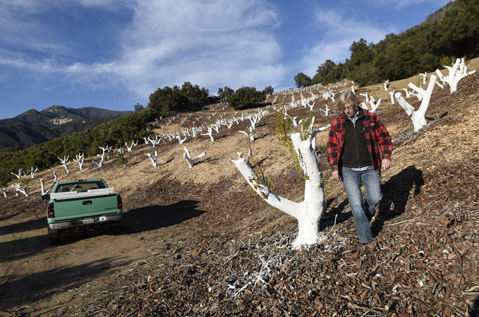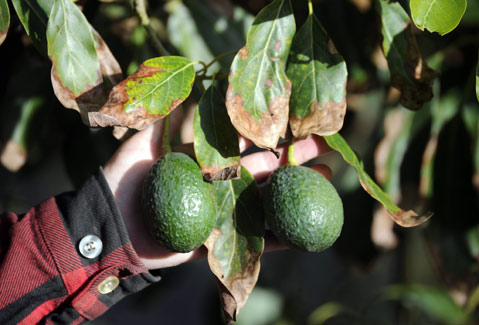‘Ugly Year’ for Avocados
Gaviota Ranchers Save Water, Finally, but Lose Their Shirts

Catherine Epperson, co-owner of the Parks Land & Cattle Co., the most productive avocado operation in the county, cannot remember a shorter harvest or a time when the future was more uncertain.
The fruit was small because of the drought, the picking season ended three months early because of record summer heat, and the ranch in Las Varas Canyon lost several hundred thousand dollars, Epperson said. On top of that, she said, they’ve been hit with $135,000 in drought surcharges from the Goleta Water District since July 1.
Epperson’s not counting on a bailout from El Niño storms. If Lake Cachuma goes dry next year, she said, the ranch could run out of water — if it doesn’t run out of money first. As it is, she’s cut back the trees to stumps on 100 acres, taking a third of the ranch out of production — twice as much as planned.
“2015 has been a very ugly year,” Epperson said. “This is like the worst ever. The surcharge is making water pretty much unaffordable. Over time, the trees will die without water.”
Parks Land & Cattle and 21 other ranches between Glen Annie and Las Varas canyons on the Gaviota Coast form the backbone of the county’s $60 million avocado industry. Much of their fruit goes to S.B. markets. In dry weather, they rely heavily on cheap water from Cachuma, which comes to them through a pipeline called the West Conduit.
Now, the surcharge has tripled the cost of their lake water; and Cachuma is at near-record lows. This Tuesday, the Goleta water board will consider a new ordinance regulating suspensions of Cachuma water to the Gaviota Coast.

“It’s a sad situation we’re in now,” said Frank Alegria, who coordinates the South Coast avocado harvest for Calavo Growers, Inc. “Our water’s more expensive in Goleta than anywhere else in the state for avocados. If we don’t get rain, there will be a lot of people who either lose their ranches or will have to remove a lot of their trees.”
District officials note that the ranchers could have started cutting back on their water use sooner. The district’s 87,000 urban customers are among the thriftiest in the state, but as a group, the West Conduit ranchers have increased their water use during every year of the drought except this one. In 2014, they accounted for 12 percent of district water deliveries.
“We’ve always said, ‘You can pay less if you use less,’” said Ryan Drake, district water supply and conservation manager. “Once we adopted the surcharge, then they achieved the reduction.”
In August, Goleta-area farmers and ranchers filed a lawsuit, demanding that the district reimburse them for the surcharge. But Drake said the surcharge was necessary because district revenues have plummeted as residents conserved. Between July 1-October 31, the district collected $4.4 million in drought surcharges, including $628,000 from the 22 ranchers on the West Conduit.
“I would not say they’re treated unfairly,” Drake said. “The surcharge is uniform across all customers.”
In 2014, the district set an overall water conservation target of 25 percent. Goleta residents cut their use by 27 percent, on average, compared to the 2012-2013 water year, but the West Conduit ranchers increased theirs by 5 percent. Since May of this year, the district has been asking them to cut their use by 40 percent: They have conserved 29 percent.
The faster the ranchers use up their water, the sooner their supply could be “interrupted,” Drake said. Unlike 135 farmers operating within the urban Goleta area, the ranchers on the West Conduit do not receive groundwater or state aqueduct water from the district. Surcharges aside, they pay rock-bottom water rates — less than a third of the lowest rate for urban residents — in part because their Cachuma water is not fully treated.
“They always said they want the lowest rate possible, and what comes with that is interruptibility,” Drake said. “Our remaining supply is a finite supply. Right now, we’re in a major crisis mode, and we’re just trying to keep enough water available for health and safety. There isn’t water for them to continue business as usual. It isn’t realistic.”
The district is helping ranchers by pumping groundwater around the clock for its urban customers, extending the Cachuma supply, Drake said. On Tuesday the board will consider whether to “rent” state aqueduct water from the Antelope Valley in 2016. This water is expensive and must eventually be returned, but it would help stretch the Cachuma supply, Drake said — and the surcharge would help pay for it.
“We do value agriculture,” he said. “We’re not just saying, ‘Tough luck.’”
Some of the ranchers on the West Conduit have their own wells — Epperson, for example, recently refurbished six that have been dormant since 1991 — but the water tends to be salty and less than optimal for trees. For their homes, the ranchers get free bottled drinking water, at a cost to the district of about $35,000 yearly.
Paul Van Leer, general manager of the Las Varas and Edwards ranches, with 165 acres in avocados and 30 in lemons, said he lost a couple hundred thousand dollars in this year’s avocado harvest. He said he has paid more than $80,000 in drought surcharge fees to date and stumped 40 acres of avocado trees — about half a million dollars’ worth of production — cutting his water use by more than 30 percent. Van Leer signed the lawsuit on behalf of Goleta ranchers in August.
“Charging us is not going to make us conserve any more,” he said. “We have cut way back.”
Epperson said Parks Land & Cattle had achieved a water savings of 45 percent, going well beyond district targets. The district failed to plan for an extensive drought, she said.
“I believe the district’s mentality was, ‘The drought’s going to go away: It won’t last more than three years,’” Epperson said.
During the last drought, from 1987-1991, the district gave each customer a water allocation: For ranchers, it was based on the number of trees in their orchards. Water use that exceeded the allocations was billed at four to 10 times the highest rate. There were no district-wide surcharges.
“Rather than do something that was going to put farmers completely out of business, we said, ‘This is how much water you have to keep your orchard alive until it rains again,’” said Kevin Walsh, a former Goleta Water District engineer who now serves on the Santa Ynez water district Board of Trustees. “They understood and lived within it and came out of the drought just fine.”
Alegria believes allocations would have been preferable this time to blanketing all users with a surcharge. “If everybody had gotten the allocation, it would have been an incentive for them to save,” he said. “It would have put each grower in charge of whether he would save or spend more money. Now, even if they conserve, they’re spending more.”
But Drake said the allocation system was “too inequitable: In the last drought, it was a universal thumbs-down.”
“We don’t want to tell them how to run their business,” he said. “They’ve been through this before, and we saw a lot of the same issues and struggles. Then the rains came back and they were operating again.”



